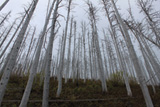Invertebrates
“The plow is one of the most ancient and most valuable of man’s inventions; but long before he existed the land was in fact regularly plowed, and still continues to be thus plowed by earthworms. It may be doubted whether there are many other animals which have played so important a part in the history of the world, as have these lowly organized creatures.”
- Charles Darwin, The Formation of Vegetable Mould Through the Action of Worms, 1837
Invertebrates are animals that have no internal skeletal structure, such as insects and worms. They make up an amazing 95% of all the species on earth and are critical to all other life forms. Insects are found in the earliest fossil records, and numerous species have adapted and survived the ever changing environment of the planet for as long as it has supported life. Their generally small size makes it easy for us to overlook both their numbers–over a million species have been identified–and their importance.
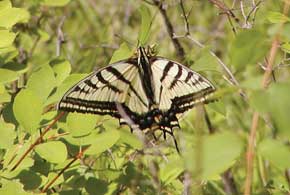 |
 |
| Figure 2.73: Butterfly. Source: Lori Curtis | Figure 2.74: Ladybug. Source: PDPhoto.org |
They play a central role in the pollination of plants, with every bee and butterfly pollinating thousands of plants throughout their short life spans. They eat the debris of life that would otherwise build up and bury civilization, and they process plant matter into essential soil. Flying, crawling, and larval stage insects provide nutrition to birds and mammals, even the grizzly bear. From predator to prey, insects play significant and beneficial roles in our terrestrial and aquatic food chains.
“The ant finds kingdoms in a foot of ground.”
- Stephen Vincent Benét, John Brown’s Body, 1928
In addition to all the good they do, insects also carry and spread diseases to other species. From malaria to the plague, the negative impact of insects has been clearly evident for humans. Other insects are known for the damage they cause to plant life and agricultural crops. Flathead Watershed tree species have suffered numerous insect pest attacks, but none more noticeable today than the tremendous wrath of the tiny, yet mighty native mountain pine beetle (Dentroctonus ponderosa). At a mere 1/8th to 1/4th inch long (.3 - .6 cm), the beetle bores its way through pine bark to lay its eggs.
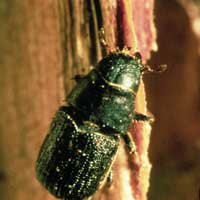 |
| Figure 2.75: Mountain pine beetle. Source: U.S. Forest Service |
The hatched larvae create a labyrinth of tunnels through the bark of the tree. When enough of them tunnel the tree, they cut off the supply of nutrients and water between the roots and the foliage of the tree. While healthy trees can typically survive mountain pine beetle attacks, crowded forests of both healthy and unhealthy trees may succumb to their infestation. Extended periods of -40°F (-40°C) can kill the insects in their larval stage, though most areas in the watershed rarely experience several consecutive days at this temperature. Although these infestations are a natural occurrence, they have left thousands of acres of forest with dry, red, dead trees primed for fueling large forest fires.
Western spruce budworm
One of the most widely distributed and destructive defoliators in the watershed are the native western spruce budworm (Choristoneura occidentalis). The budworm was first reported in western Canada in 1909 and in the U.S. in 1914, but was not recognized as a serious threat to coniferous forests in the northwest until 1922. An epidemic of infestations that began in the Rocky Mountains in 1949 continues to impact Douglas-fir, sub alpine fir, spruce, and larch forests throughout the watershed today. The budworms prefer warm, dry locations, and stands with dense, multi-layered canopies of trees. As caterpillars, they feed on older growth needles until new needles appear.
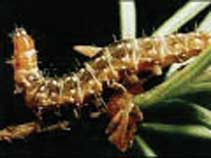 |
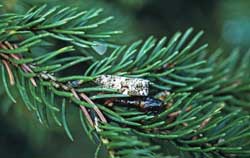 |
| Figure 2.76: Western Spruce budworm. Source: U.S. Forest Service | Figure 2.77: Budworm in tree. Source: U.S. Forest Service |
In the late summer, they spin silken shelters in which they feed and grow. After moths emerge in August, they mate and lay eggs on the underside of needles. Eggs hatch in late summer and the young caterpillars migrate to bark crevices for the winter. Unlike the mountain pine beetle, the white spruce budworm is not generally affected by cold temperatures. However, very low temperatures in late spring or early summer can kill larvae by freezing them or by killing their food supply.
Insect life is robust in The Flathead Watershed, in spite of the cold temperatures of the air and water and the short growing season. Some insects, crustaceans and worms spend part of their larval life stages underground in water and in floodplains, and part of it flying above and near the water playing an active role in both the aquatic and terrestrial ecosystems. The watershed is home to more than 300 species of aquatic insects—the highest diversity of aquatic insects found anywhere in the Rocky Mountains from New Mexico to the Yukon—including one-fourth of all the stoneflies in North America, some found only in the watershed.
The highest diversity of stoneflies recorded anywhere in the world was at one site in the Flathead. These invertebrates, in their various stages, provide food for fish, birds, and bats. While mammals and birds tend to more easily attract our attention, a closer look at the many little creatures with which we share the watershed can be an illuminating and humbling experience.

